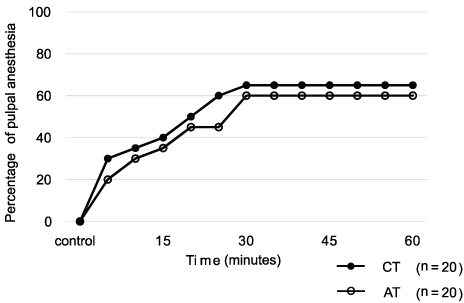J Dent Anesth Pain Med.
2015 Jun;15(2):63-68.
Advantages of anterior inferior alveolar nerve block with felypressin-propitocaine over conventional epinephrine-lidocaine: an efficacy and safety study
- Affiliations
-
- 1Department of Dental Anesthesiology, The Nippon Dental University, School of Life Dentistry at Tokyo, Tokyo, Japan. hazuki.s@tky.ndu.ac.jp
Abstract
- BACKGROUND
Conventional anesthetic nerve block injections into the mandibular foramen risk causing nerve damage. This study aimed to compare the efficacy and safety of the anterior technique (AT) of inferior alveolar nerve block using felypressin-propitocaine with a conventional nerve block technique (CT) using epinephrine and lidocaine for anesthesia via the mandibular foramen.
METHODS
Forty healthy university students with no recent dental work were recruited as subjects and assigned to two groups: right side CT or right side AT. Anesthesia was evaluated in terms of success rate, duration of action, and injection pain. These parameters were assessed at the first incisor, premolar, and molar, 60 min after injection. Chi-square and unpaired t-tests were used for statistical comparisons, with a P value of < 0.05 designating significance.
RESULTS
The two nerve block techniques generated comparable success rates for the right mandible, with rates of 65% (CT) and 60% (AT) at both the first molar and premolar, and rates of 60% (CT) and 50% (AT) at the lateral incisor. The duration of anesthesia using the CT was 233 ± 37 min, which was approximately 40 min shorter than using the AT. This difference was statistically significant (P < 0.05). Injection pain using the AT was rated as milder compared with the CT. This difference was also statistically significant (P < 0.05).
CONCLUSIONS
The AT is no less successful than the CT for inducing anesthesia, and has the added benefits of a significantly longer duration of action and significantly less pain.
MeSH Terms
Figure
Reference
-
1. Malamed SF. Handbook of Local Anesthesia. 4th ed. St.Louis, MO: Times-Mirror Co., Mosby;1997. p. 232–235.2. Jastak JT, Yagiela JA, Donaldson D. Local Anesthesia of the Oral Cavity. 1st ed. Philadelphia, PA: W.B. Saunders Co.;1995. p. 283–284.3. Takasugi Y, Furuya F, Moriya K, Okamoto Y. Clinical evaluation of inferior alveolar nerve block by injection into the pterygomandibular space anterior to the mandibular foramen. Anesth Prog. 2000; 47:125–129.4. Sunada K, Nakamura K, Yamashiro M, Sumitomo M, Furuya H. Clinically safe dosage of felypressin for patients with essential hypertension. Anesth Prog. 1996; 43:108–115.5. Satish SV, Shetty KP, Kilaru K, Bhargavi P, Reddy ES, Bellutgi A. Comparative evaluation of the efficacy of 2% lidocaine containing 1:200,000 epinephrine with and without hyaluronidase (75 IU) in patients with irreversible pulpitis. J Endod. 2013; 39:1116–1118.
Article6. Malamed SF. Handbook of Local Anesthesia. 4th ed. St.Louis, MO: Times-Mirror Co., Mosby;1997. p. 38–43.7. Miyoshi T, Aida H, Kaneko Y. Comparative study on anesthetic potency of dental local anesthetics assessed by the jaw opening reflex in rabbits. Anesth Prog. 2000; 47:35–41.8. Sasao M. In search for the ideal local anesthetic in dentistry. J Japanese Dental Soc Anesthesiol. 2006; 34:126. [In Japanese].9. Nordenram Å, Danielsson K. Local anaesthesia in elderly patients. An experimental study of oral infiltration anaesthesia. Swed Dent J. 1990; 14:19–24.10. Petersen JK, Lück H, Kristensen F, Mikkelsen L. A comparison of four commonly used local analgesics. Int J Oral Surg. 1977; 6:51–59.
Article11. Padfield A. The intradermal local analgesic action of prilocaine. Anaesthesia. 1967; 22:556–561.
Article
- Full Text Links
- Actions
-
Cited
- CITED
-
- Close
- Share
- Similar articles
-
- Vascular effects of the inferior alveolar nerve injection of 2% lidocaine hci with 1:100,000 epinephrine
- Updates on the Inferior Alveolar Nerve Block Anesthesia
- A clinical study of anesthetic efficacy of alkalinizing lidocaine in inferior alveolar nerve blocks
- The efficacy of an elevated concentration of lidocaine HCl in impacted lower third molar surgery
- Diplopia and Infeiro Rectus Muscle Palsy after Posterior Superior Alveolar Nerve Block




